
Glass, with its elegance and transparency, is a versatile material used in various applications, from windows and glass table tops to vintage glass and crystal items. However, cleaning glass effectively can be quite challenging. The smooth and reflective nature of glass makes it prone to showing streaks, smudges, and blemishes. In this comprehensive guide, our cash for houses agency in Fort Worth (we can sell your house for cash in 24 hours – even if it’s a fixer upper that needs expensive repairs!) will explore why glass is difficult to clean, why popular cleaning methods often fall short, and what glass items can and cannot be put in the dishwasher.
We will also provide detailed instructions and expert tips on cleaning various types of glass, including windows, vintage glass and crystal, wine glasses, glass table tops, shower doors, crystal items, and fish tank aquarium glass.
Why glass is difficult to clean
Cleaning glass surfaces presents unique challenges due to several factors:
- Streak visibility: Glass surfaces are unforgiving when it comes to streaks, making it challenging to achieve a streak-free finish.
- Dust and dirt: Glass readily collects dust, dirt, and grime, necessitating frequent cleaning to maintain clarity.
- Fingerprints and smudges: Oils and moisture from our skin often leave unsightly fingerprints and smudges, particularly on items frequently touched.
- Hard water stains: Glass exposed to hard water can develop mineral deposits that are challenging to remove with standard cleaning methods.
- Delicate nature: Glass can be easily scratched or damaged if not handled and cleaned properly.
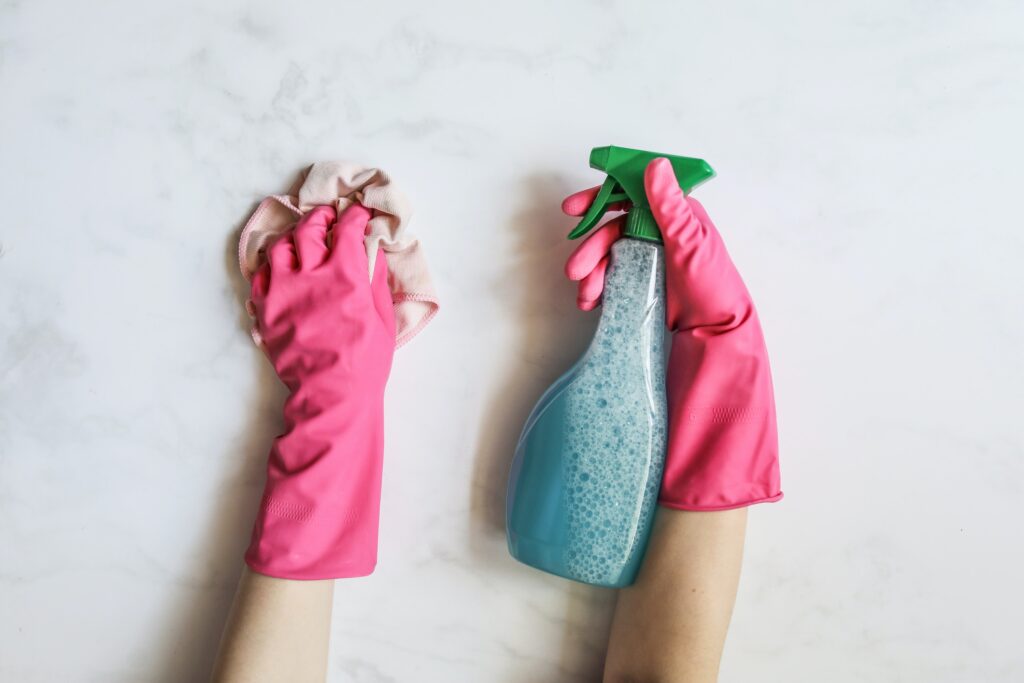
Common cleaning methods that don’t work!
Popular cleaning methods often prove ineffective for glass surfaces. Here are common pitfalls to avoid:
- Newspaper: The notion that newspaper is effective for cleaning glass is a common misconception. It can leave ink residue and often fails to achieve a streak-free shine.
- Household cleaners: Many household cleaners contain chemicals that can leave streaks or dull the glass’s appearance.
- Ammonia-based cleaners: While ammonia can cut through grease and grime, it can damage some types of glass and emit strong fumes that may be harmful to health.
- Paper towels: Paper towels can leave behind lint and fibers, causing streaks and an unsightly appearance.
- Incorrect technique: Using improper techniques, such as circular motions or applying too much pressure, can result in streaks and scratches.
Now, let’s look into specific glass cleaning techniques for various types of glass!
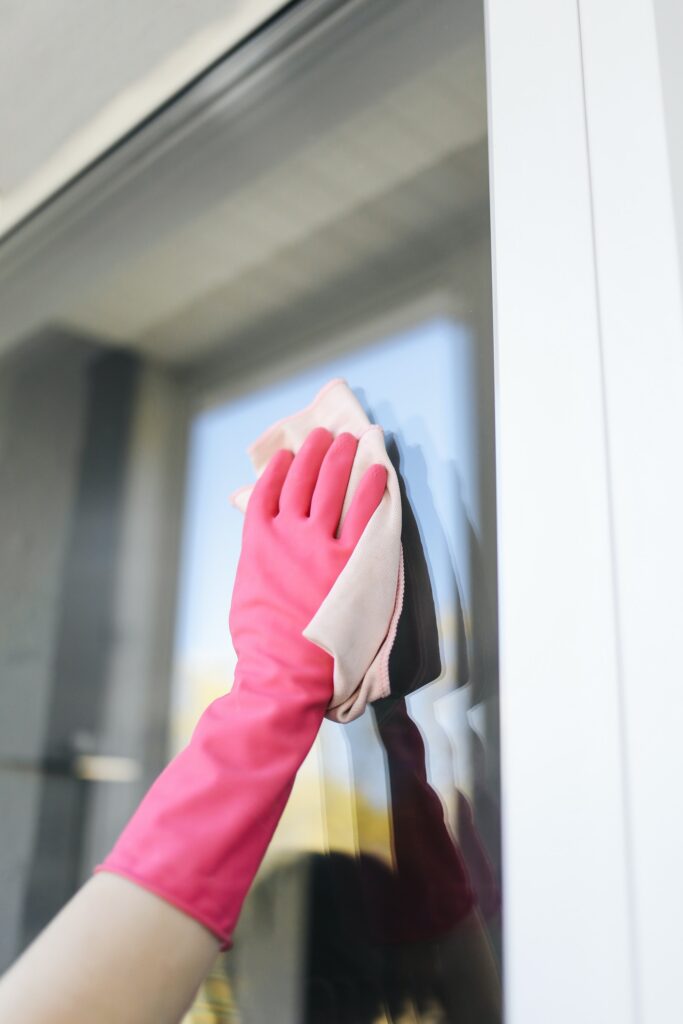
How to clean windows
Clean windows not only enhance the aesthetics of your home but also allow natural light to shine through. Here’s how to achieve spotless windows:
Equipment and cleaning products:
- Squeegee
- Microfiber cloth or lint-free paper towels
- Bucket
- Mild dish soap or specialized window cleaner
- Water
Technique:
- Begin by removing loose dust and dirt from the window frame and sill using a brush or vacuum cleaner attachment.
- Prepare a solution of warm water and a few drops of mild dish soap or window cleaner in a bucket.
- Dip a clean, lint-free cloth or sponge into the soapy water and gently scrub the window surface, paying extra attention to stains or spots.
- Use a squeegee to remove the soapy water from the glass. Start at the top and pull it downward in a straight, horizontal motion, wiping the squeegee blade with a clean cloth after each pass.
- Dry any remaining moisture around the edges with a clean, dry microfiber cloth or lint-free paper towel.
Tips on how to clean windows
- Choose a cloudy day to clean windows to prevent the cleaning solution from drying too quickly, which can lead to streaks.
- Avoid cleaning windows in direct sunlight, as it can cause the cleaning solution to evaporate rapidly and leave streaks.
- For stubborn spots or stains, use a mixture of equal parts white vinegar and water.
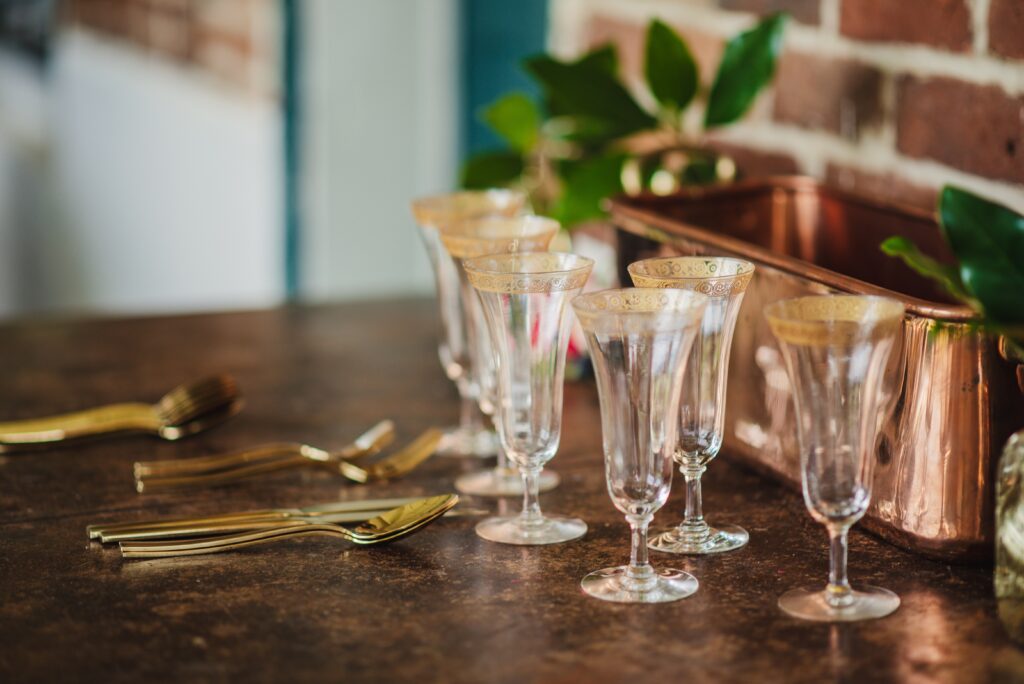
How to clean vintage glass and crystal
Vintage glass and crystal items require extra care to preserve their beauty and value:
Equipment and cleaning products:
- Mild dish soap
- Warm water
- Soft, lint-free cloth
- Soft brush (e.g., a makeup brush)
Technique:
- Fill a basin with warm water and add a few drops of mild dish soap.
- Submerge the vintage glass or crystal item in the soapy water and use a soft brush or cloth to gently clean the surface, paying attention to intricate details.
- Rinse the item thoroughly with warm water to remove any soap residues.
- Dry the item with a soft, lint-free cloth, patting and wiping gently to avoid streaks.
Tips for cleaning crystal
- Avoid using abrasive materials or harsh chemicals on vintage glass and crystal, as they can damage or dull the surface.
- Never put them in the dishwasher
- Handle these delicate items with care to prevent chipping or breakage.

How to clean wine glasses
Wine glasses can be delicate and prone to smudges and residues. Proper cleaning is crucial to preserve their clarity and shine:
Equipment and cleaning products:
- Soft-bristle brush
- Mild dish soap
- Warm water
- Microfiber cloth
Technique:
- Rinse the wine glasses immediately after use with warm water to remove any wine residues.
- Fill a sink or basin with warm water and add a few drops of mild dish soap.
- Gently scrub the interior and exterior of the wine glasses with a soft-bristle brush, paying attention to the base and rim.
- Rinse the wine glasses thoroughly with warm water to remove all soap residues.
- Dry the wine glasses with a lint-free microfiber cloth, holding them by the stem to avoid leaving fingerprints on the bowl.
Tips for cleaning wine glasses
- Avoid using abrasive materials or harsh chemicals on wine glasses, as they can damage the glass and compromise its clarity.
- Store wine glasses upright to prevent dust and lint from settling inside.
- Don’t put them in the dishwasher if their stems are too long.
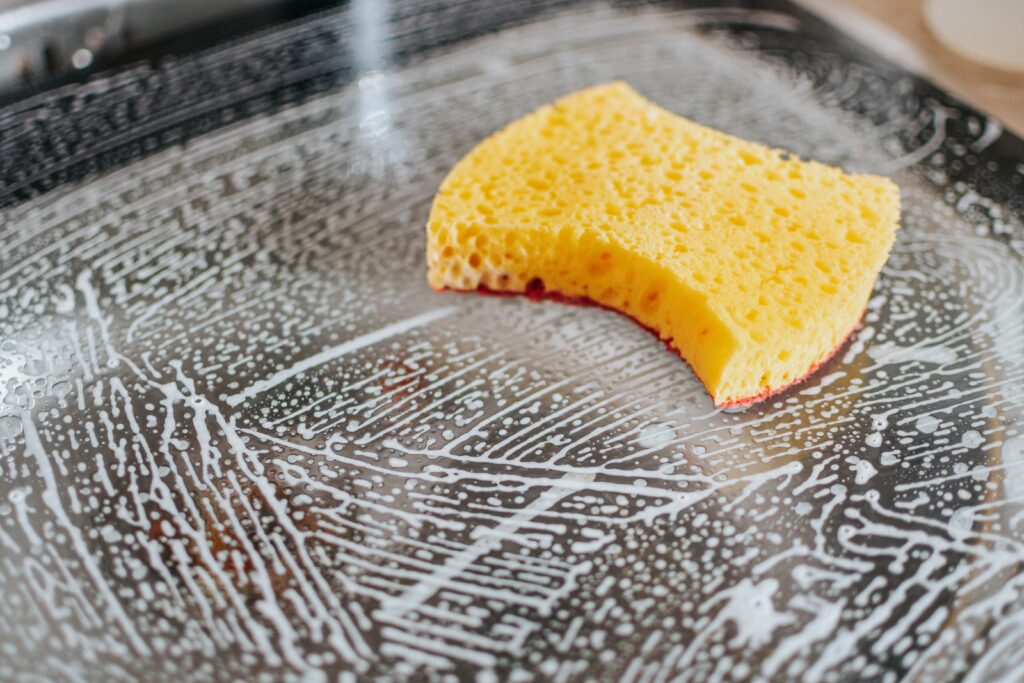
How to clean glass table tops
Glass table tops are susceptible to dust, smudges, and fingerprints. Here’s how to keep them gleaming:
Equipment and cleaning products:
- Microfiber cloth or lint-free paper towels
- Glass cleaner or a solution of equal parts white vinegar and water
Technique:
- Start by removing loose debris or dust from the glass surface using a dry microfiber cloth.
- Spray a small amount of glass cleaner or the vinegar-water solution onto the glass surface.
- Wipe the glass in a straight, vertical motion, overlapping each pass slightly, until you’ve covered the entire surface.
- If stubborn spots or streaks persist, spot-clean by spraying a bit more cleaner directly onto the affected area and gently wiping with a clean cloth.
- Finish by buffing the glass with a dry microfiber cloth to remove any remaining cleaning solution and leave a streak-free shine.
Tips for cleaning glass tables:
- Use separate cloths for cleaning and buffing to avoid transferring dirt or streaks.
- Regularly clean the underside of the glass table top to prevent dust buildup.
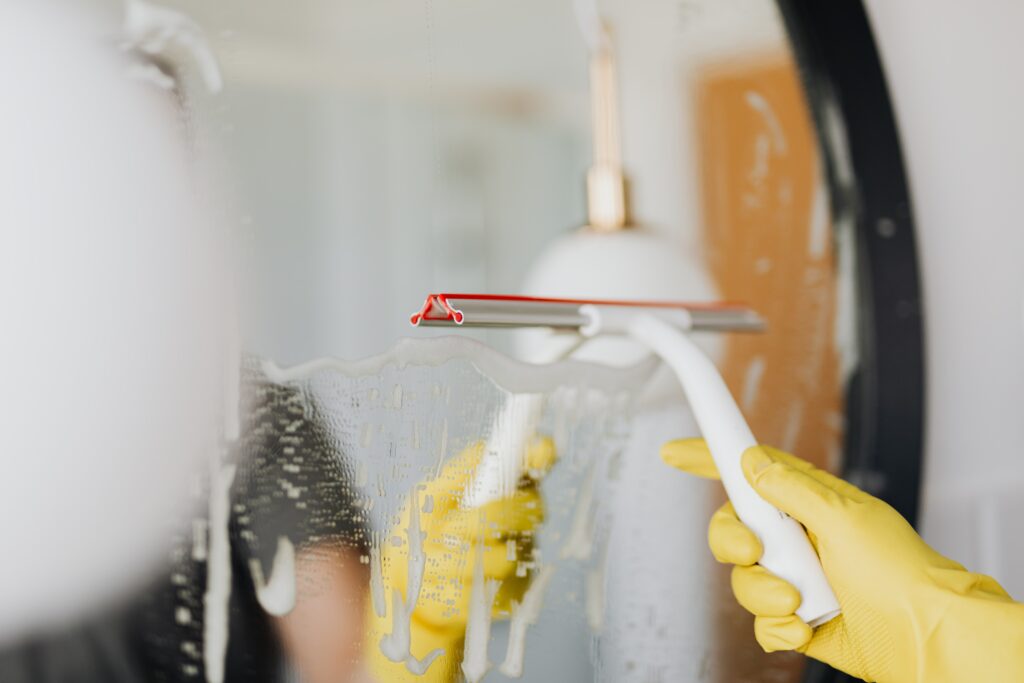
How to clean glass shower doors
Shower doors can quickly accumulate soap scum, mineral deposits, and water spots. Keeping them clean improves both aesthetics and durability:
Equipment and cleaning products:
- White vinegar
- Baking soda
- Soft sponge or scrubbing pad
- Warm water
- Microfiber cloth or squeegee
Technique:
- Test the water quality in your area and ensure it’s not contributing to mineral buildup on your shower doors. High mineral content can lead to stubborn stains.
- Create a paste by mixing equal parts white vinegar and baking soda. Apply the paste to the shower door, concentrating on areas with soap scum or mineral deposits.
- Allow the paste to sit for approximately 15 minutes to break down the buildup.
- Use a soft sponge or scrubbing pad to gently scrub the door, paying attention to stubborn spots.
- Rinse the door thoroughly with warm water to remove the paste and residue.
- Dry the door using a microfiber cloth or a squeegee, starting from the top and working your way down in a straight, horizontal motion.
Tips on how to clean glass shower doors:
- Squeegee the shower door after each use to prevent water spots and soap scum buildup.
- For daily maintenance, mix equal parts white vinegar and water in a spray bottle and spritz the shower door after each use.
- Clean as you shower!
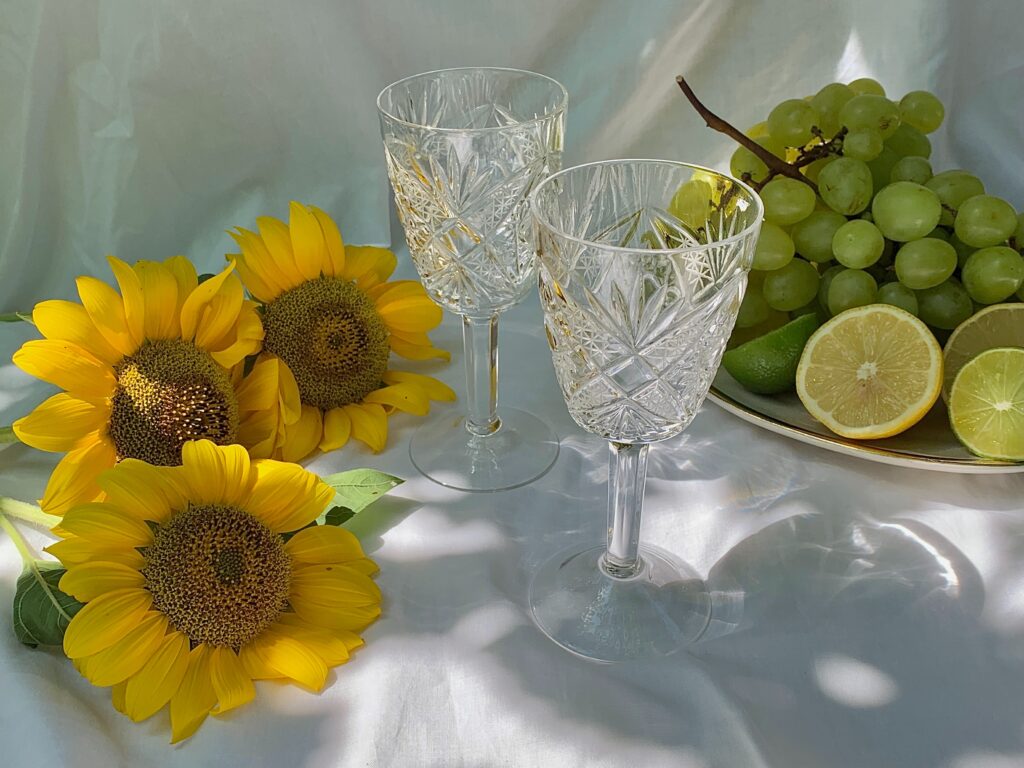
How to clean crystal glasses and vases
Crystal items, such as vases, bowls, and figurines, require gentle care to maintain their sparkle and brilliance:
Equipment and cleaning products:
- Mild dish soap
- Warm water
- Soft, lint-free cloth
- Soft brush (e.g., a makeup brush)
Technique:
- Fill a basin with warm water and add a few drops of mild dish soap.
- Submerge the crystal item in the soapy water and use a soft brush or cloth to gently clean the surface, paying attention to intricate details.
- Rinse the item thoroughly with warm water to remove any soap residues.
- Dry the crystal item with a soft, lint-free cloth, gently patting and wiping to avoid leaving streaks.
Tips for cleaning cut glass and crystal:
- Avoid using abrasive materials or harsh chemicals like bleach or ammonia on crystal, as they can scratch or dull the surface.
- Handle crystal items with care to prevent chipping or breakage.

How to clean glass aquariums
Maintaining a clean and clear glass surface in your fish tank is crucial for both the health of your aquatic pets and the visual appeal of the aquarium:
Equipment and cleaning products:
- Algae scraper or magnetic cleaner
- Aquarium-safe glass cleaner (avoid any with ammonia)
- Aquarium water test kit
Technique:
- Begin by testing the water in your aquarium to ensure it’s safe for your fish. High ammonia or nitrate levels can contribute to algae growth on the glass.
- Use an algae scraper or a magnetic cleaner designed for aquariums to remove algae and debris from the glass. These tools allow you to clean the glass without disturbing your fish.
- If necessary, spot-clean any stubborn algae or mineral deposits with an aquarium-safe glass cleaner. Be sure to follow the product’s instructions and avoid using cleaners containing ammonia.
- Regularly maintain your aquarium water quality by performing water changes and controlling nutrient levels to prevent excessive algae growth.
Tips for cleaning aquarium glass:
- Do not use regular glass cleaners with ammonia in your aquarium, as it can harm your fish and other aquatic life.
- Avoid using abrasive materials or rough sponges on the aquarium glass, as they can scratch the surface.
- If you use a scraper that has a blade, be very careful around the joins, as it can damage the glue and lead to leaks.
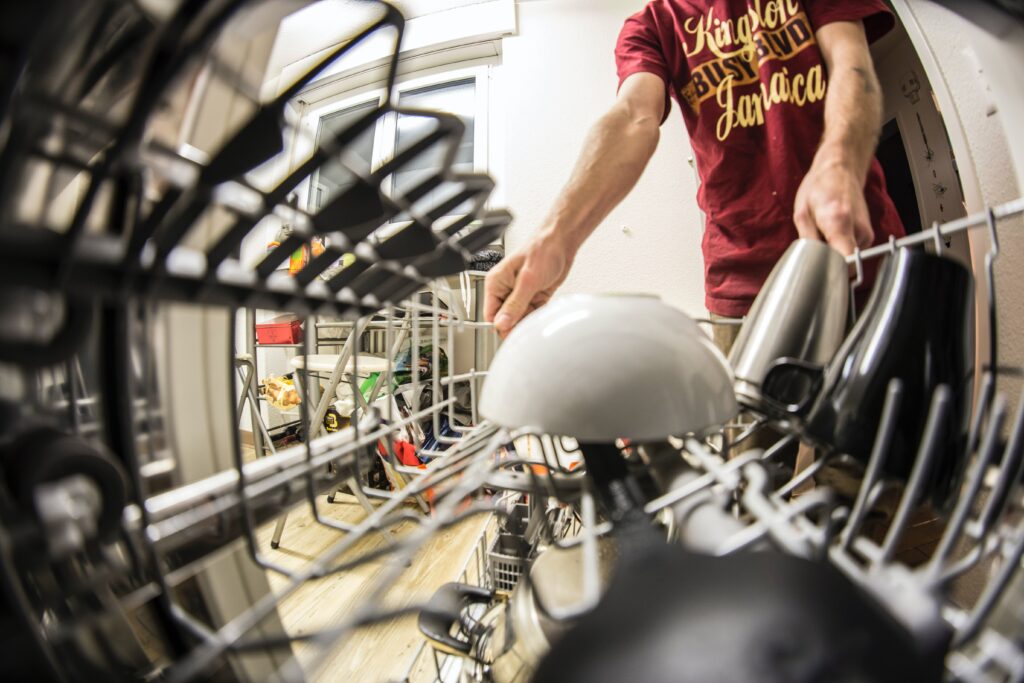
What belongs in the dishwasher and what doesn’t
Many glass items can be safely cleaned in the dishwasher, but some should be washed by hand to prevent damage. Here’s a general guideline:
Dishwasher-safe glass items:
- Drinking glasses
- Glass food storage containers
- Glass bakeware (check the manufacturer’s recommendations)
Hand-wash only glass items:
- Vintage glass and crystal
- Delicate glassware with gold or metallic accents
- Hand-painted glass items
- Fragile glass ornaments
Cleaning glass, though challenging, can be achieved effectively with the right techniques and equipment. From windows to vintage glass and crystal, wine glasses to glass table tops, shower doors to crystal items, and even fish tank aquarium glass, maintaining the cleanliness and clarity of glass surfaces is essential. By following the expert advice and tips provided in this guide, you can ensure that your glass items sparkle and shine, enhancing the beauty of your surroundings and preserving their longevity. Additionally, knowing what glass items can and cannot go in the dishwasher helps you maintain these valuable possessions with confidence and care.
Want to sell your house without repairs? Get a FREE, no-obligation quote from our cash property buyers in Fort Worth!
Need to sell your house? There’s no need to stage your house or host an open house! You can sell directly to the best Fort Worth cash property buyers! What’s more, you can also ask us for a FREE no-obligation quote to see how we measure up. As reputable cash real estate buyers, we price your house according to the market, so you get a fair deal in record time, making it a simple and stress-free process to sell your house. And we can even help you get out of foreclosure quickly!
It’s the perfect option if you want to sell a house as is without having to look for a buyer, deal with a real estate agent and pay their commission, do house repairs, or even empty the house. It is also a quick and easy way to sell an inherited house or to sell a distressed property, especially if you live out of state.
So, how do you how to sell your house during to our Fort Worth cash property buyers?
Here’s how our process works at Shiny Key Properties
- You enter your information on our website. We’ll contact you directly to discuss an offer for your house (you can also get a free house evaluation from our website)
- You can accept or reject the FREE NO-OBLIGATION offer
- Cash will be deposited into your bank account – with no real estate agent fees or realtor fees
- We can handle all aspects of the process, including clearing out the house
- You can also call us directly on 469-858-0088
That’s all there is to it!
Our team at Shiny Keys Property is compassionate and highly motivated to offer you the best possible market-related price for your house, so you can sell your house quickly and easily. Not only does this cash go straight into your bank account as soon as the sale goes through, but you also pay no real estate agent fees or commission. It’s the best way to sell your house as is, and it makes our Fort Worth cash property buyers the best buyer for your property.

